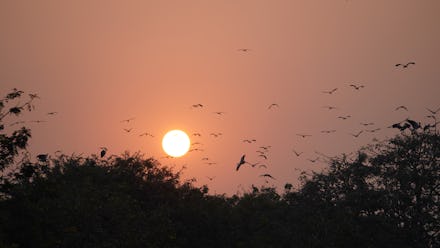As the planet warms, starving birds are falling from the sky in a "mass die-off"

When it comes to the climate crisis, birds face many more serious threats than running into the blades of a wind turbine. According to a report from The Guardian, migrating birds across the southwestern United States have started to just… die, in many cases falling from the sky or starving before reaching their destinations. The tragic situation that has killed thousands of birds is, as you might have guessed, a result of conditions caused by climate change.
According to researchers at New Mexico State University, a number of species including flycatchers, swallows, wood-pewees, and warblers are experiencing a "mass die-off" as they attempt to make their way across parts of New Mexico, Colorado, Texas, Arizona, and Nebraska. There is no official death toll for the birds at this point, but experts warned The Guardian that the figures could be in the hundreds of thousands already, with more to come.
Many of the affected species are insectivores and long-distance migrants that spend the fall months making the trip from parts of Alaska and Canadadown to Central and South America for the winter. During that trip, they pass through parts of the western and southern US. Typically on these trips, the birds would stop every couple days to scavenge for food and replenish themselves before continuing the journey.
That has become untenable for a variety of reasons, most of which are linked directly to the effects of climate change. As California and much of the West Coast continues to burn as a result of historically devastating wildfires, many of the birds have been pushed away from migratory routes with the essential resources needed to fuel their trip. Instead, they have been pushed more inland, over desert regions and areas that are drier than usual thanks to the rising global temperature. The birds rely on insects as their primary source of food, and the dry conditions across the US have resulted in fewer being available. A recent cold wave in Colorado which led to parts of the state experiencing a swing from 90-degree temperatures to snowfall over the course of just 36 hours likely made matters even worse.
Observers have seen birds that typically keep a distance and hang around in trees become approachable on the ground as they search for insects. In some cases, the birds have displayed little of the energy that they typically would. Unfortunately, many of these birds have ended up dying of starvation.
"The birds seem to be in relatively good condition, except that they are extremely emaciated. They have no fat reserves and barely any muscle mass," Allison Salas, a graduate student at NMSU, wrote on Twitter. "Almost as if they have been flying until they just couldn’t fly anymore."
Details on just how widespread this trend has become are still unknown, but researchers have created a project where people can submit bird deaths that they have encountered to help put a figure on the death toll and help determine the cause of the crisis.
Bird die-offs aren't a new phenomenon, and mass bird deaths like this have been recorded for well over a century. In most cases, the sudden loss of life is associated with an extreme weather event. The same seems to be the case here, though the extreme weather appears to not just be a singular event, but the ongoing effects of climate change.